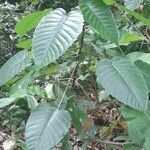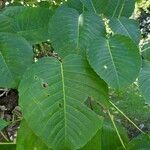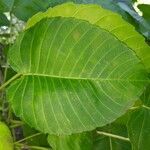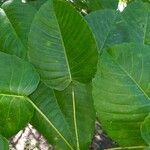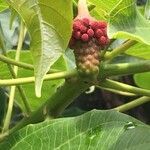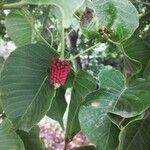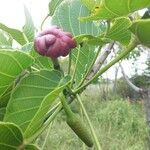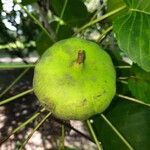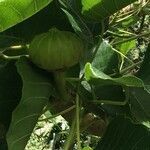Trees up to 40 m tall in wild; stem and main branches densely spiny; indumentum yellowish brown; branches densely lenticellate, glabrous. Stipules lanceolate or ovate-lanceolate, 10-15 × 2-3 mm, pubescent, caducous; petiole 4-20 cm, apex with 2 glands; leaf blade broadly ovate, 5-29 × 5-17 cm, papery, abaxially pilose along midrib, adaxially glabrous, base cordate, margins ± shallowly dentate-serrate, apex caudate-acuminate, mucronulate; midrib elevated on both surfaces, lateral veins 10-13(-16) on each side. Male flowers: inflorescence ovoid-conical, (1.6-)4-5 × (0.8-)1.5-2 cm, mostly dark red; peduncles (1.2-)7-10 cm, often with solitary female flower at base; pedicel ca. 2 mm; calyx tube 2-3 mm; stamen connectives and filaments connate into column, 4-12 mm, longest at base of catkin; anthers in (1 or)2 or 3 whorls. Female flowers: pedicel 10-17 mm, after anthesis up to 6 cm; calyx tube truncate, 4-6(-8) mm, enclosing ovary; style column 2-5 cm; stigmatic disk dark purple, 1.5-2.5 cm in diam., with 11-14 obtuse lobes, spreading radially. Fruiting pedicel pendent, to 6 cm; fruit oblate, 3-5 × 8-9 cm in diam., becoming reddish brown, concave at apex and base, longitudinally grooved. Seed ca. 2 cm in diam. Fl. May, fr. Aug.
Trees to 25 m, but often kept much lower when used as living fence posts. Leaves on petioles to 20 cm long; blade ovate to orbicular, 12-25 cm long and 7-15 cm wide, prominently penninerved, sparsely long-pubescent on the lower surface, the base cordate, the margin crenate with teeth often glandular tipped, the apex acuminate to subcuspidate. Staminate flowers 60-80 on conical fleshy axis 2-4.5 cm long, peduncle to 10 cm long; calyx to 1 mm long; staminal column to 2 mm long with 2-3 verticels of anthers, the third rarely complete. Pistillate flowers with pedicels to 5 cm long; calyx 3-5 mm long, truncate, or rarely shallowly 5-toothed; stylar column 2.5-5 cm long, the fleshy apical disc to 1 cm diam with radiating tips an additional 1 cm long. Capsule woody, oblate, to ca 8 cm diam, 3-5 cm long, dehiscing explosively into ca 15 crescentic cocci; seeds smooth, flattened, sub-orbicular, to 2 cm diam.
Trees, to 30 m; latex copious, caustic. Leaves: stipules leaving scar around stem, 6–10 × 2–4 mm; petiole 10–20 cm, glands 2 adaxially at apex; blade broadly ovate to orbiculate, 10–25 × 8–15 cm, base cordate, margins crenate-serrulate with 10–20 teeth on each side, apex acuminate; midvein and secondary veins prominent. Staminate inflorescences: peduncle (2–)5–10(–15) cm, fertile portion 2–5 cm, 60–80-flowered; staminate bracts membranaceous, enclosing flowers prior to anthesis. Pedicels: pistillate 1–5 cm. Staminate flowers: calyx cup-shaped, 1 mm, 3–5-lobed; staminal column to 2.5 mm, anthers usually in 2, rarely in 3, whorls. Pistillate flowers red; calyx cup-shaped, 3–5(–8) mm, 5-lobed; style 30–50 mm, terminating in thick apical disc 1 cm diam. with 5–20 radiating lobes 5–10 mm. Capsules depressed-globose, 3–5 × 6–10 cm. Seeds brownish, 15–20 mm diam., 5–8 mm thick, smooth.
A large tree. It grows 25-60 m tall. The trunk and branches are spiny in young plants. It does not have buttresses. The leaves are heart shaped and have teeth. The side veins are straight and parallel. Broken leaves have a toxic sap. The flowers are in a cone shaped stalked head. The flowers are deep red. The fruit is a small capsule. It starts green but turns brown. The seed pod explodes when ripe.
